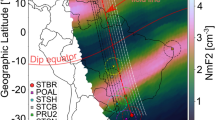Abstract
Spikes are some obvious sharp increases that appear on the raw light curves of Insight-HXMT’s High Energy X-ray telescope(HE), which could have influences on data products like energy and power spectra. They are considered to be fake triggers generated by large signals. In this paper, we study the spikes’ characteristic and propose two methods to remove spikes from the raw data. According to the different influences on energy and power spectra, the best parameters for removing the spikes is selected and used in the Insight-HXMT data analysis software. The generation mechanism of spikes is also studied using the backup HE detectors on ground and the spikes can be reduced by the electronic design.















Similar content being viewed by others
Notes
All Insight-HXMT data used in this work are publicly available and can be downloaded from the official website of Insight-HXMT: http://archive.hxmt.cn/proposal.
References
Zhang, S.N., Li, T., Lu, F., Song, L., Xu, Y., Liu, C., Chen, Y., Cao, X., Bu, Q., et al.: Overview to the hard X-ray modulation telescope (Insight-HXMT) satellite. Sci. China Phys. Mechan. Astron. 63(4) (2020). https://doi.org/10.1007/s11433-019-1432-6
X. Li, X. Li, Y. Tan, Y. Yang, M. Ge, J. Zhang, Y. Tuo, B. Wu, J. Liao, Y. Zhang, L. Song, S. Zhang, J. Qu, S.n. Zhang, F. Lu, Y. Xu, C. Liu, X. Cao, Y. Chen, J. Nie, H. Zhao, C. Li.: In-flight calibration of the insight-hard x-ray modulation telescope. J High Energy Astrophys 27(64) (2020). https://doi.org/10.1016/j.jheap.2020.02.009
C. Liu, Y. Zhang, X. Li, X. Lu, Z. Chang, Z. Li, A. Zhang, Y. Jin, H. Yu, Z. Zhang, M. Fu, Y. Chen, J. Ji, Y. Xu, J. Deng, R. Shang, G. Liu, F. Lu, S. Zhang, Y. Dong, T. Li, M. Wu, Y. Li, H. Wang, B. Wu, Y. Zhang, Z. Zhang, S. Xiong, Y. Liu, S. Zhang, H. Liu, Y. Yang, F. Zhang.: The high energy x-ray telescope (He) onboard the insight-hxmt astronomy satellite. Sci China Phys Mech Astronomy 63(4), 249503 (2020). https://doi.org/10.1007/s11433-019-1486-x
X. Cao, W. Jiang, B. Meng, W. Zhang, T. Luo, S. Yang, C. Zhang, Y. Gu, L. Sun, X. Liu, J. Yang, X. Li, Y. Tan, S. Liu, Y. Du, F. Lu, Y. Xu, J. Guan, S. Zhang, H. Wang, T. Li, C. Zhang, X. Wen, J. Qu, L. Song, X. Li, M. Ge, Y. Zhou, S. Xiong, S. Zhang, Y. Zhang, Z. Cheng, F. Zhang, M. Li, X. Liang, M. Gao, E. Yang, X. Liu, H. Liu, Y. Yang, F. Zhang.: The medium energy (me) x-ray telescope onboard the insight-hxmt astronomy satellite. Sci China Phys Mech Astronomy 63(4), 249504 (2020). https://doi.org/10.1007/s11433-019-1506-1
Y. Chen, W. Cui, W. Li, J. Wang, Y. Xu, F. Lu, Y. Wang, T. Chen, D. Han, W. Hu, Y. Zhang, J. Huo, Y. Yang, M. Li, B. Lu, Z. Zhang, T. Li, S. Zhang, S. Xiong, S. Zhang, R. Xue, X. Zhao, Y. Zhu, Y. Zhu, H. Liu, Y. Yang, F. Zhang.: The low energy x-ray telescope (le) onboard the insight-hxmt astronomy satellite. Sci China Phys Mech Astronomy 63(4), 249505 (2020). https://doi.org/10.1007/s11433-019-1469-5
Tanihata, C., Kataoka, J., Murakami, T., Ota, N., Ozawa, H., Takahashi, T., Tamura, T., Uchiyama, Y., Watanabe, S., Yamaoka, K., Yonetoku, D., Ezoe, Y., Fukazawa, Y., Isobe, N., Iyomoto, N., Kamae, T., Kokubun, M., Kotoku, J., Kubota, A., Makishima, K., Matsumoto, Y., Mizuno, T., Nakazawa, K., Onishi, T., Sugiho, M., Takahashi, I., Tanaka, M., Tashiro, M., Terada, Y., Nomachi, M., Yoshida, A., Hamaya, M., Horii, M., Taguchi, K., Morita, N., Odagi, I., Sato, K., Tanaka, Y., Mori, K.: Preflight performance of the ASTRO-E hard-x-ray detector. In: Siegmund, O.H.W., Flanagan, K.A. (eds.) EUV, X-Ray, and Gamma-Ray Instrumentation for Astronomy X, vol. 3765, International Society for Optics and Photonics (SPIE), vol. 3765. pp. 645–663. (1999) https://doi.org/10.1117/12.366546
Zhang, Y., Yi, F., Kong, W.: Analysis of relative error in detection caused by signal-induced noise in na lidar system. https://doi.org/10.1007/s11430-017-9123-4
Tudyka, K., Bluszcz, A.: A study on photomultiplier afterpulses in TL/OSL readers. Radiat. Meas. 86, 39 (2016). https://doi.org/10.1016/j.radmeas.2016.01.004
Meegan, C., Lichti, G., Bhat, P.N., Bissaldi, E., Briggs, M.S., Connaughton, V., Diehl, R., Fishman, G., Greiner, J., Hoover, A.S., et al.: Thefermigamma-ray burst monitor. Astrophys. J. 702(1), 791–804 (2009). https://doi.org/10.1088/0004-637x/702/1/791
Xiao, S., Xiong, S.L., Liu, C.Z., Li, X.B., Zhang, S.N., Ge, M.Y., Cai, C., Yi, Q.B., Zhu, Y., Chen, W., Li, X.F., Li, B., Song, L.M., Li, C.K., Song, X.Y., Chang, Z., Gao, G.H., Gao, H., Li, T.P., Li, Z.W., Lu, F.J., Lu, X.F., Xu, Y.P., Zhang, Y.F.: Deadtime calculation method of the High Energy X-ray telescope (HE) onboard the Insight-HXMT satellite. J. High Energy Astrophys. 26, 58 (2020). https://doi.org/10.1016/j.jheap.2020.02.003
Leahy, D.A., Darbro, W., Elsner, R.F., Weisskopf, M.C., Sutherland, P.G., Kahn, S., Grindlay, J.E.: On searches for pulsed emission with application to four globular cluster X-ray sources : NGC 1851, 6441, 6624 and 6712. Astrophysical Journal 266, 160 (1983). https://doi.org/10.1086/160766
Leahy, D.A., Elsner, R.F., Weisskopf, M.C.: On searches for periodic pulsed emission - The Rayleigh test compared to epoch folding. Astrophysical Journal 272, 256 (1983). https://doi.org/10.1086/161288
Acknowledgements
This work is supported by the National Natural Science Foundation of China under grants (No.U1838201, U1838202, U1838105, U1938102, U1938108, U2031205). This work made use of data from the Insight-HXMT mission, a project funded by China National Space Administration (CNSA) and the Chinese Academy of Sciences (CAS). We also thank the support from the Strategic Priority Program on Space Science, the Chinese Academy of Sciences, Grant No. XDA15020503.
Author information
Authors and Affiliations
Corresponding authors
Ethics declarations
Declarations
The authors have no relevant financial or non-financial interests to disclose.
Additional information
Publisher’s note
Springer Nature remains neutral with regard to jurisdictional claims in published maps and institutional affiliations.
Rights and permissions
About this article
Cite this article
Wu, B., Zhang, Y., Li, X. et al. The removal method and generation mechanism of spikes in Insight-HXMT/HE telescope. Exp Astron 53, 1037–1051 (2022). https://doi.org/10.1007/s10686-022-09847-8
Received:
Accepted:
Published:
Issue Date:
DOI: https://doi.org/10.1007/s10686-022-09847-8




